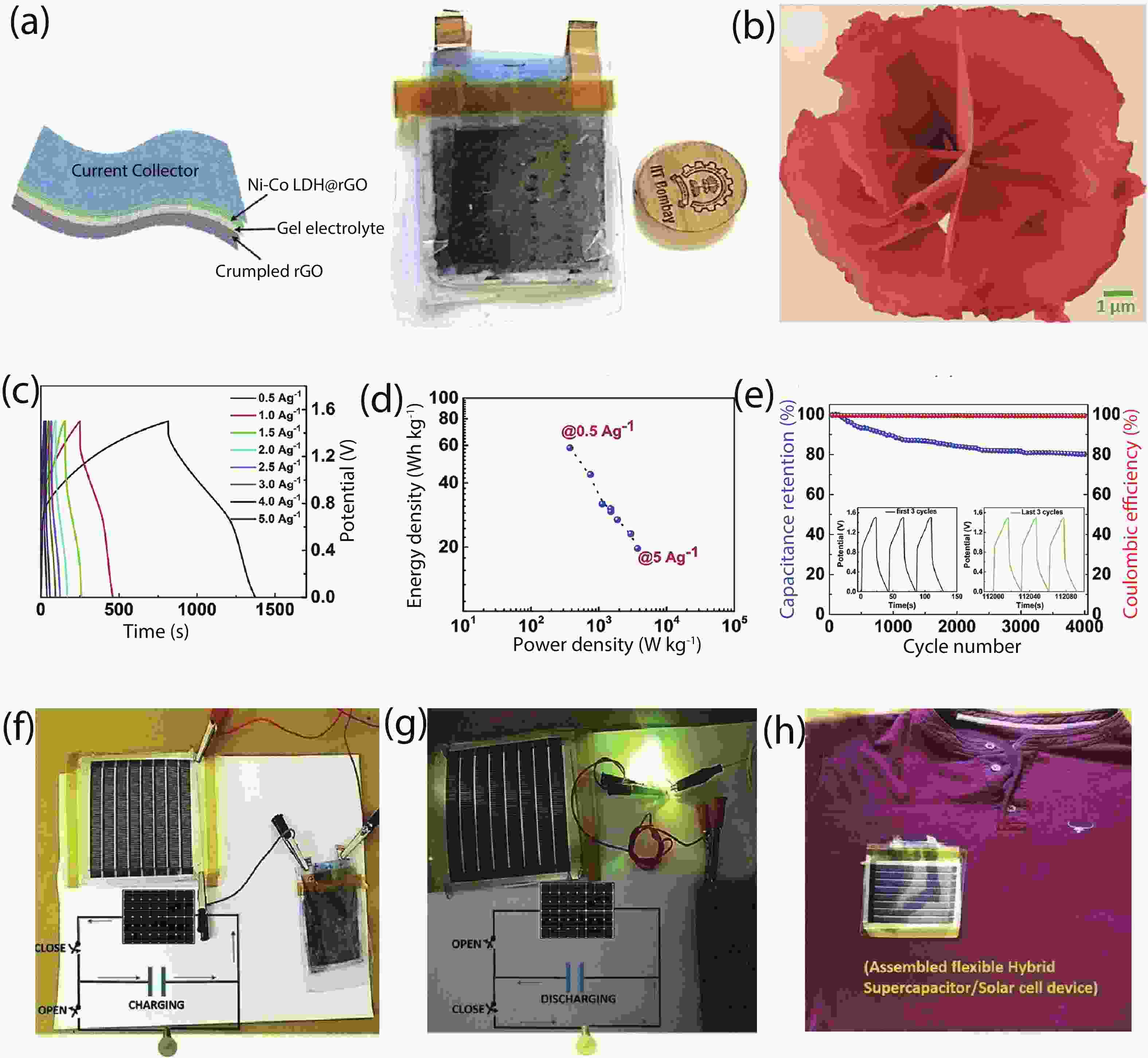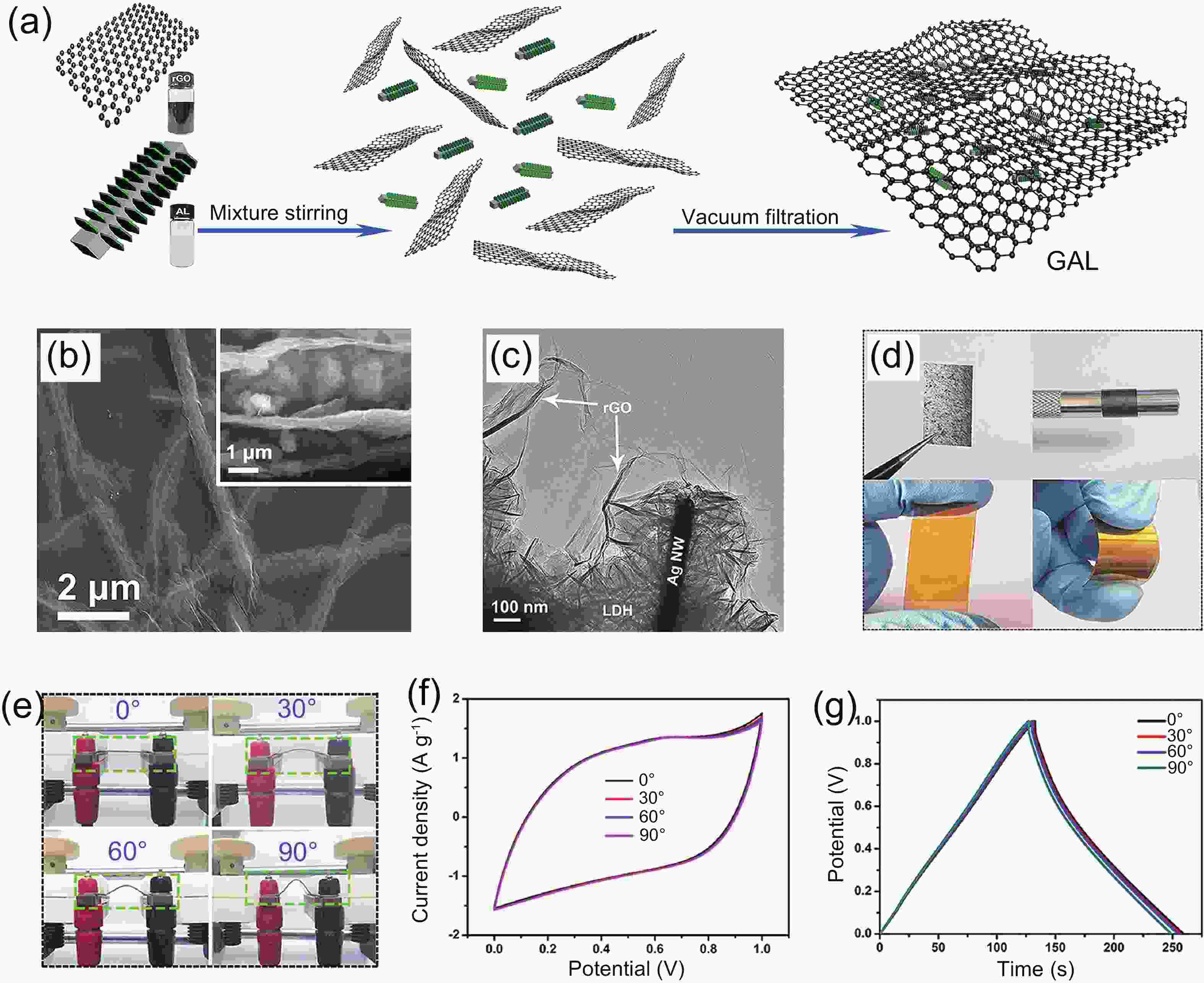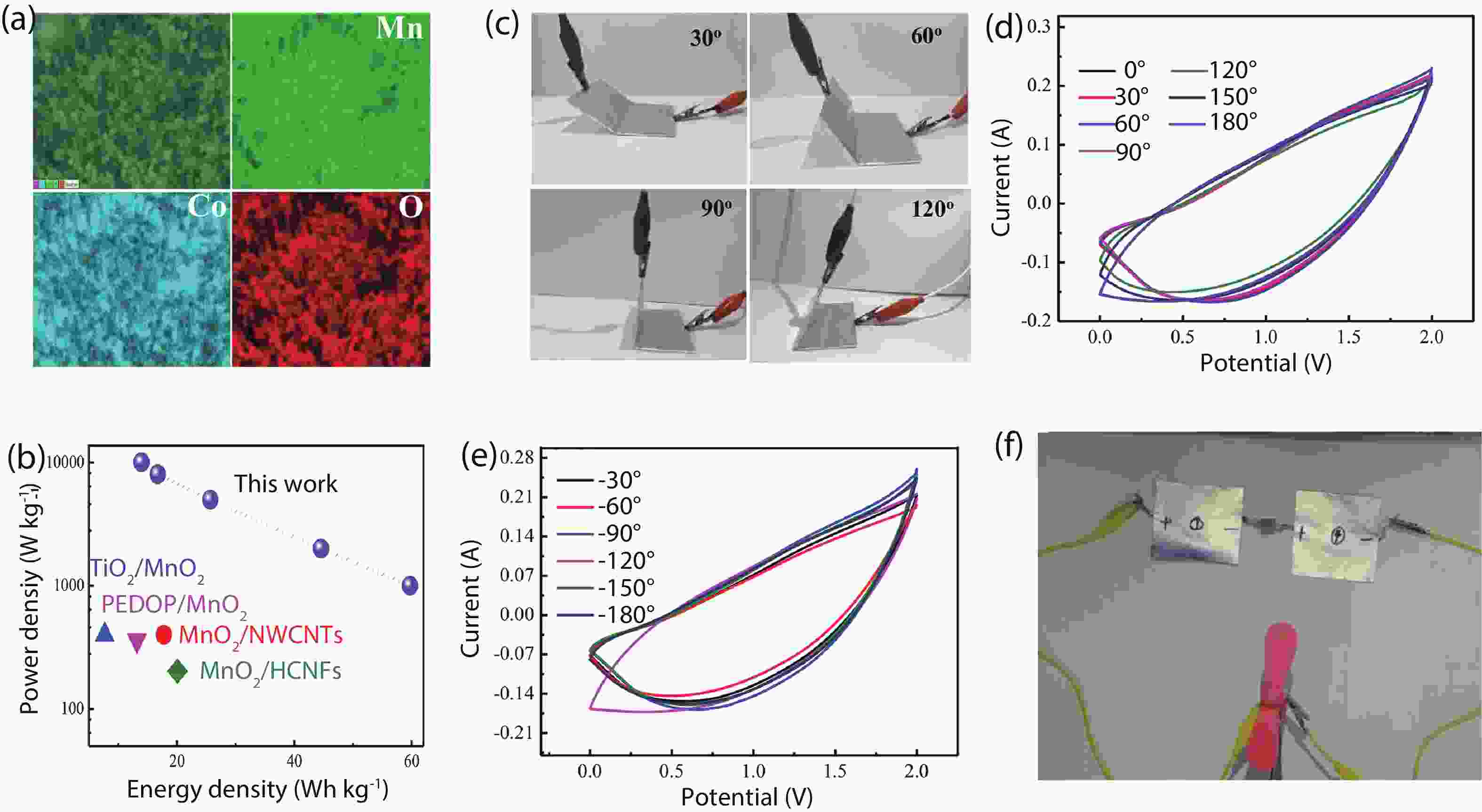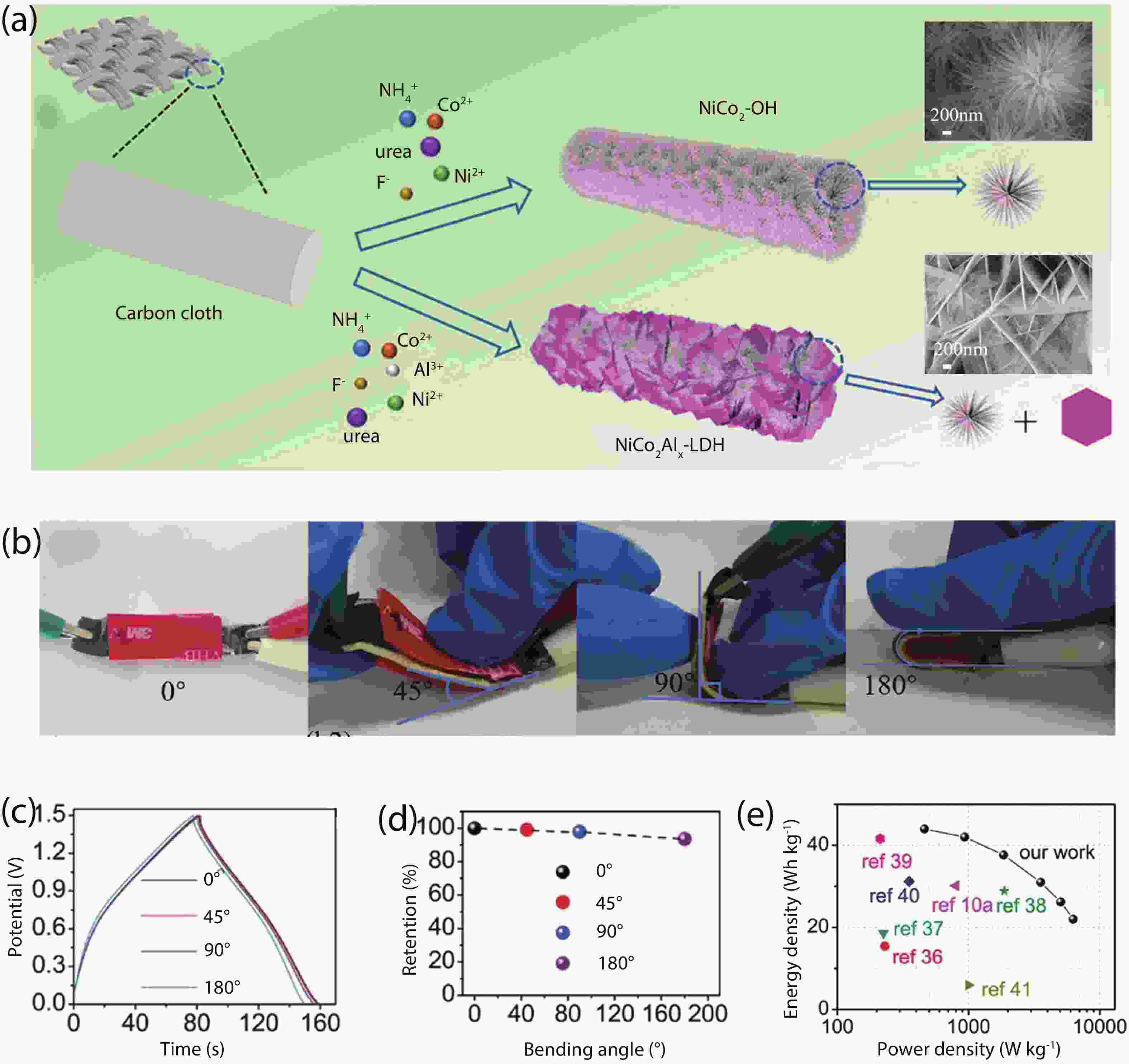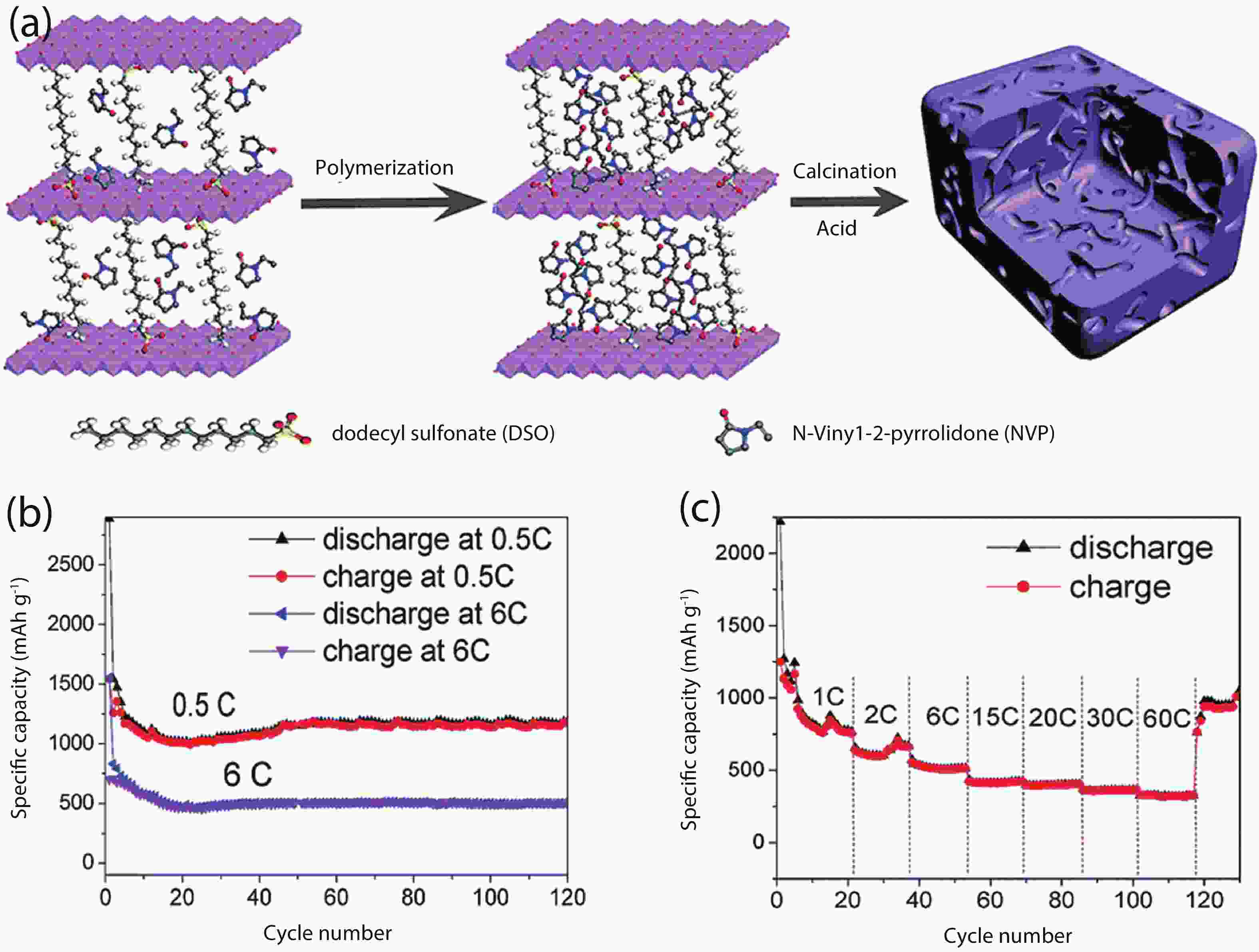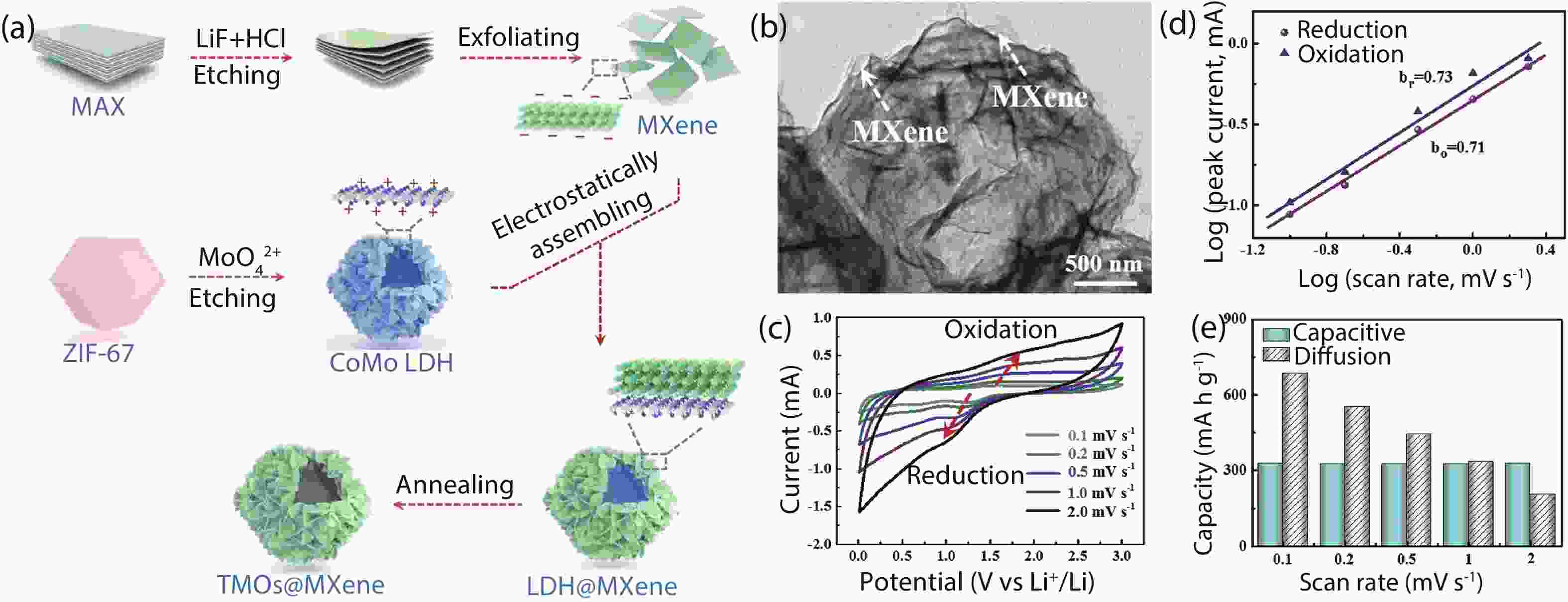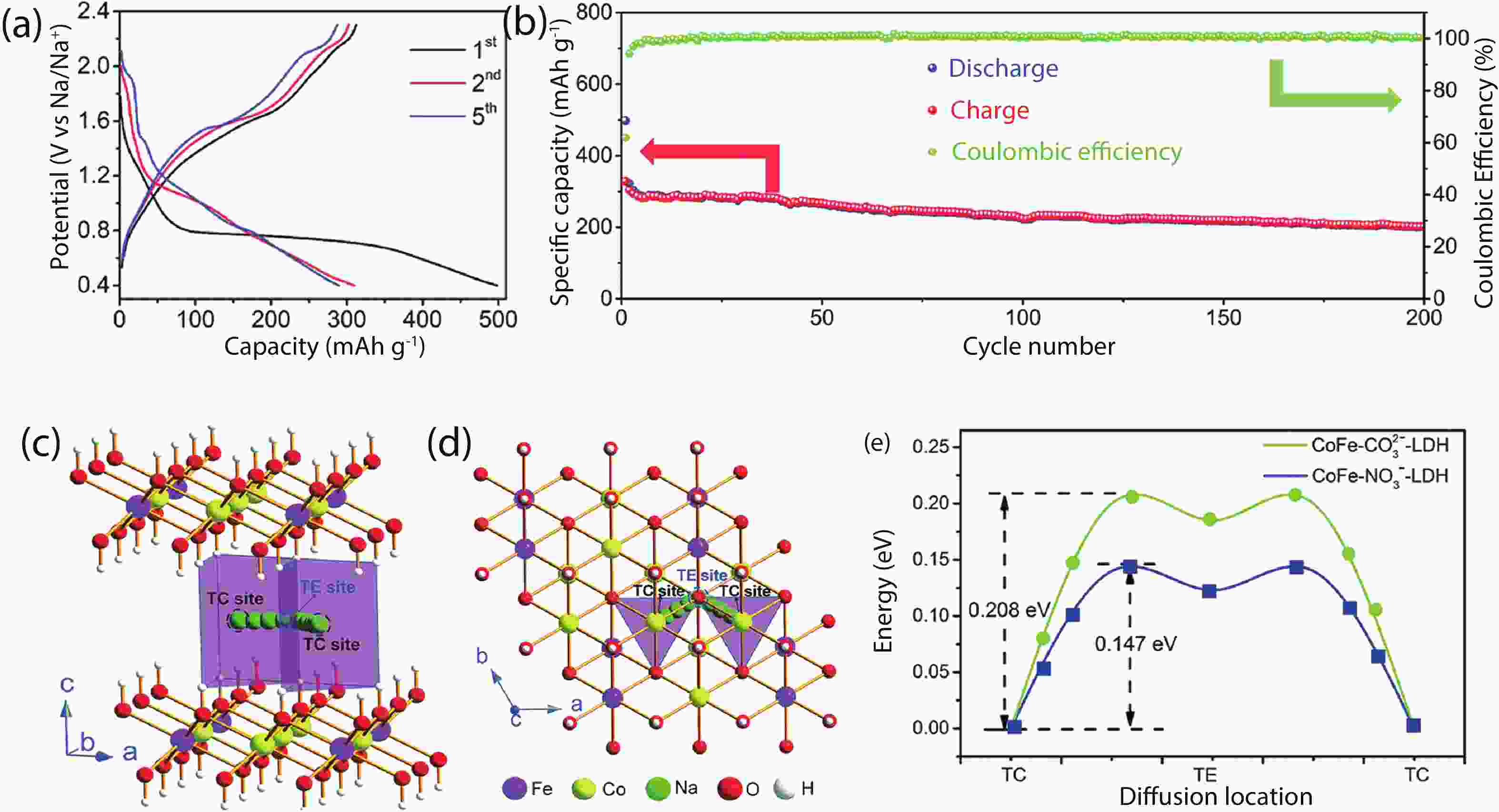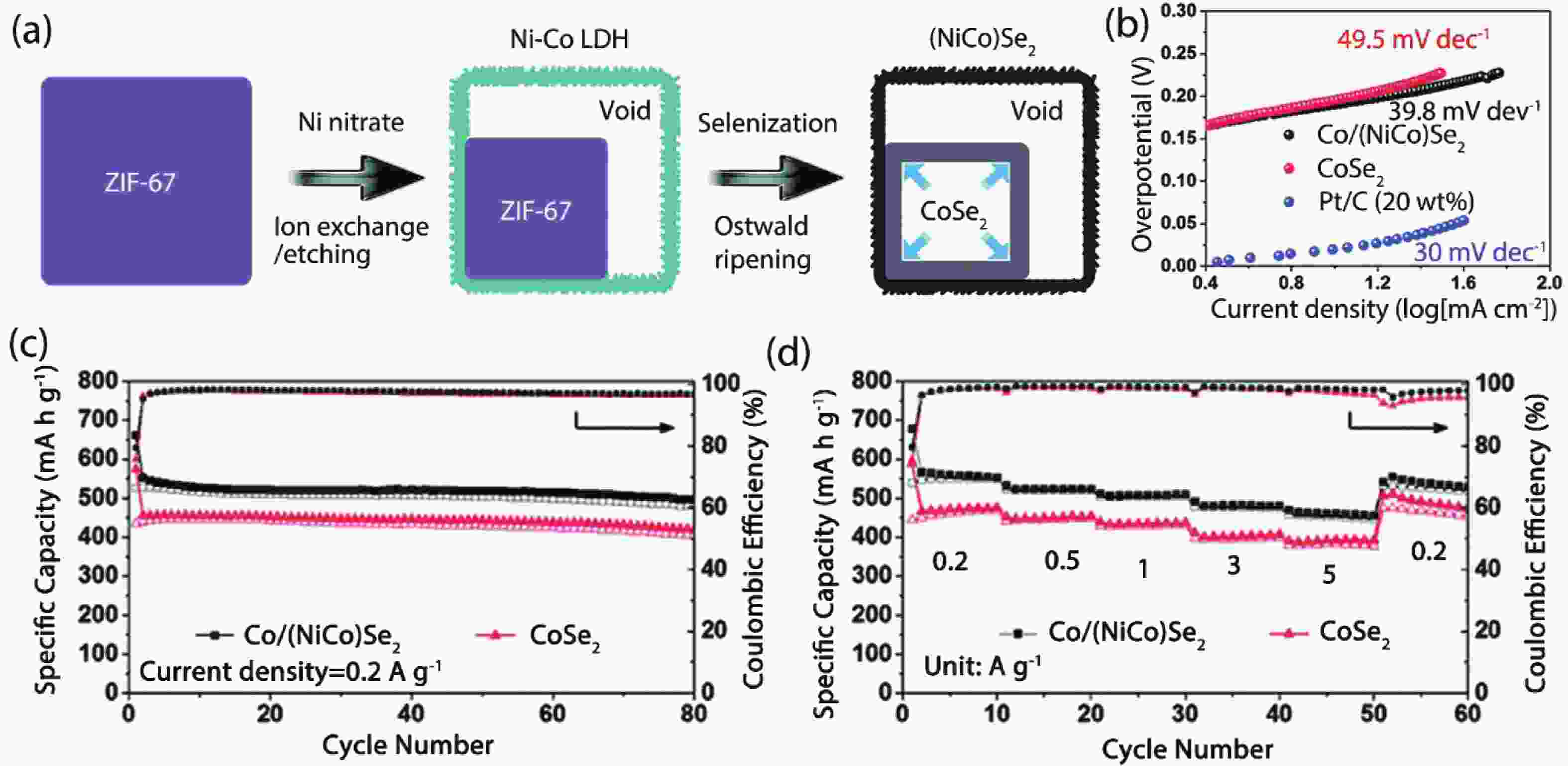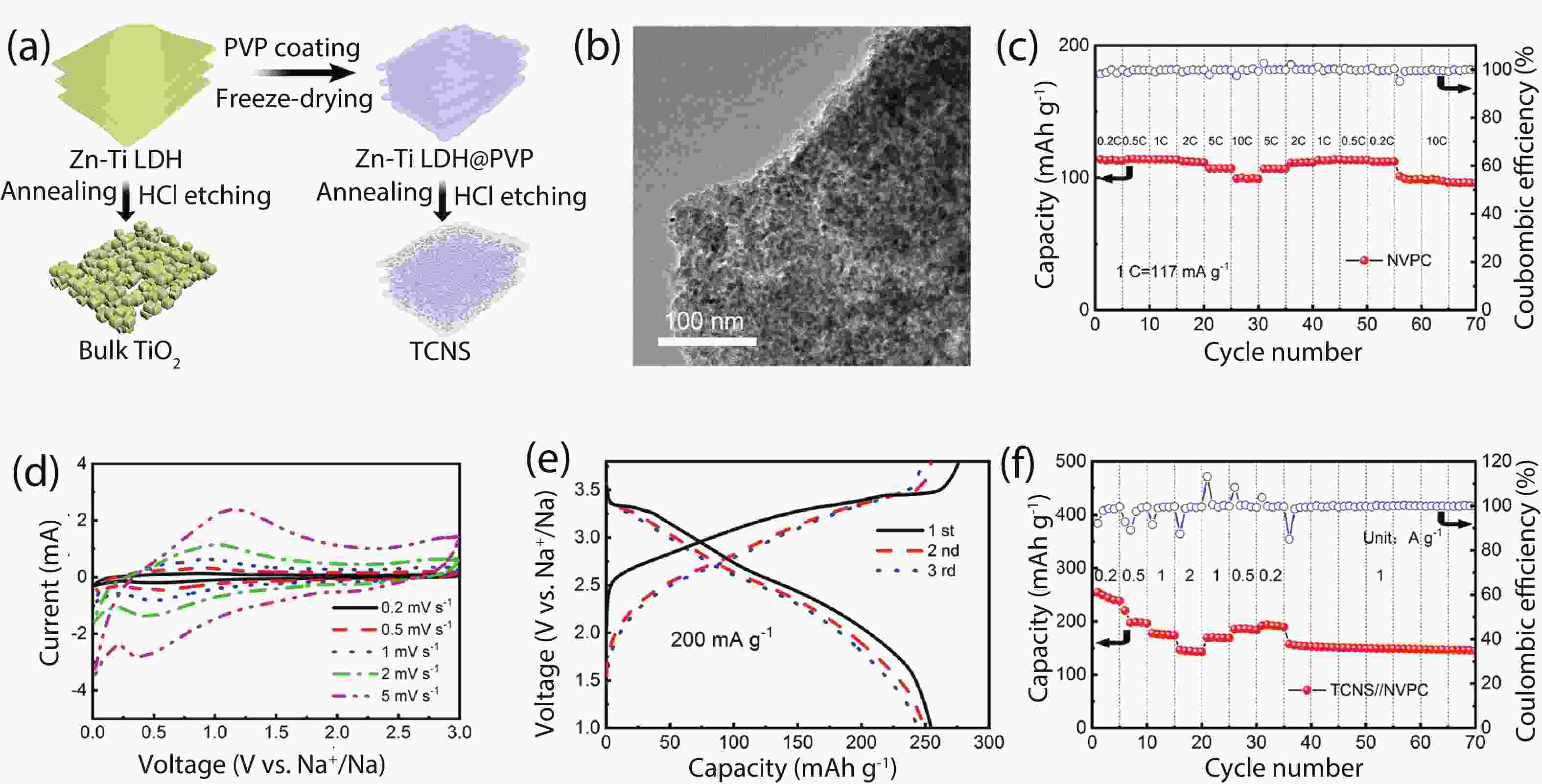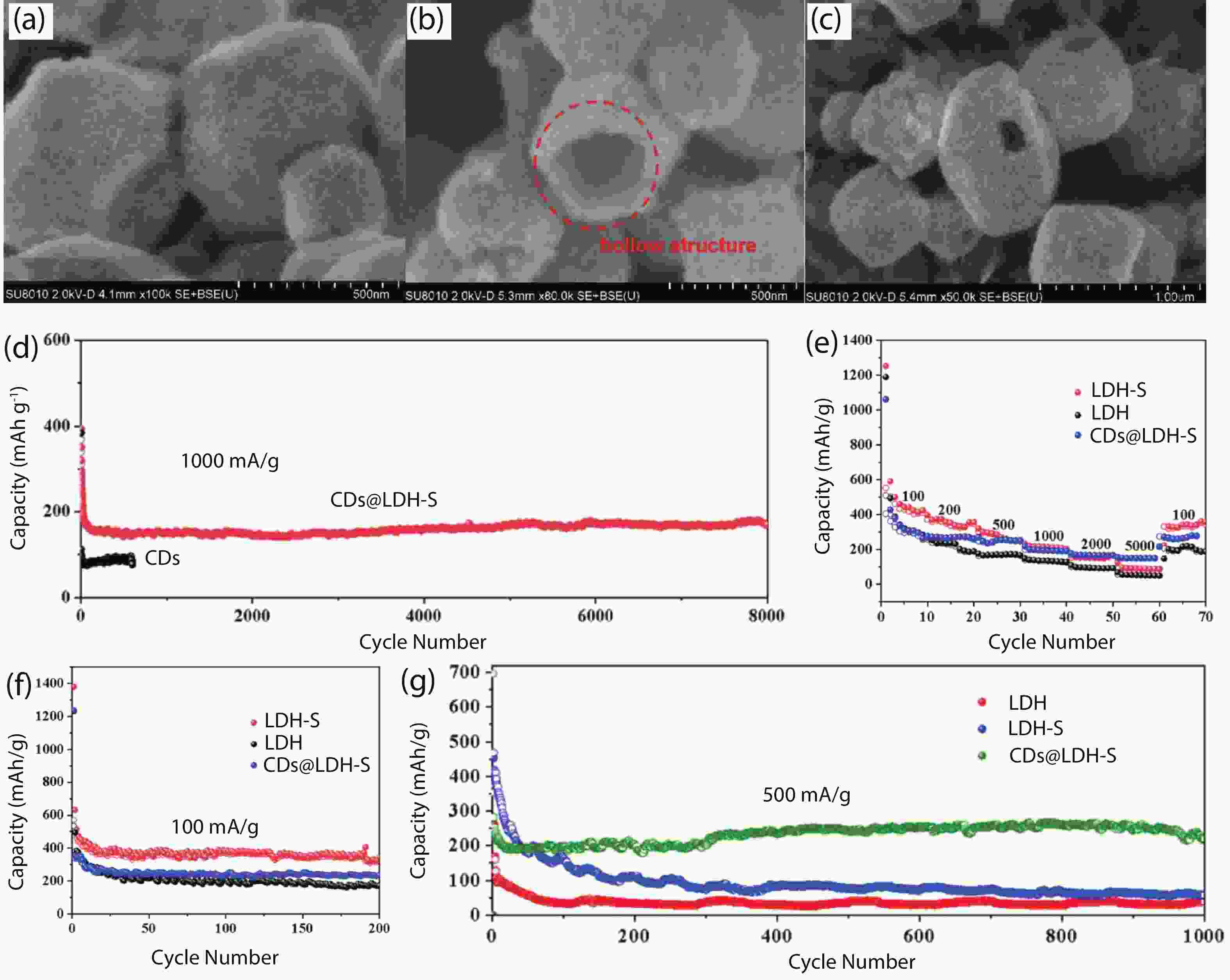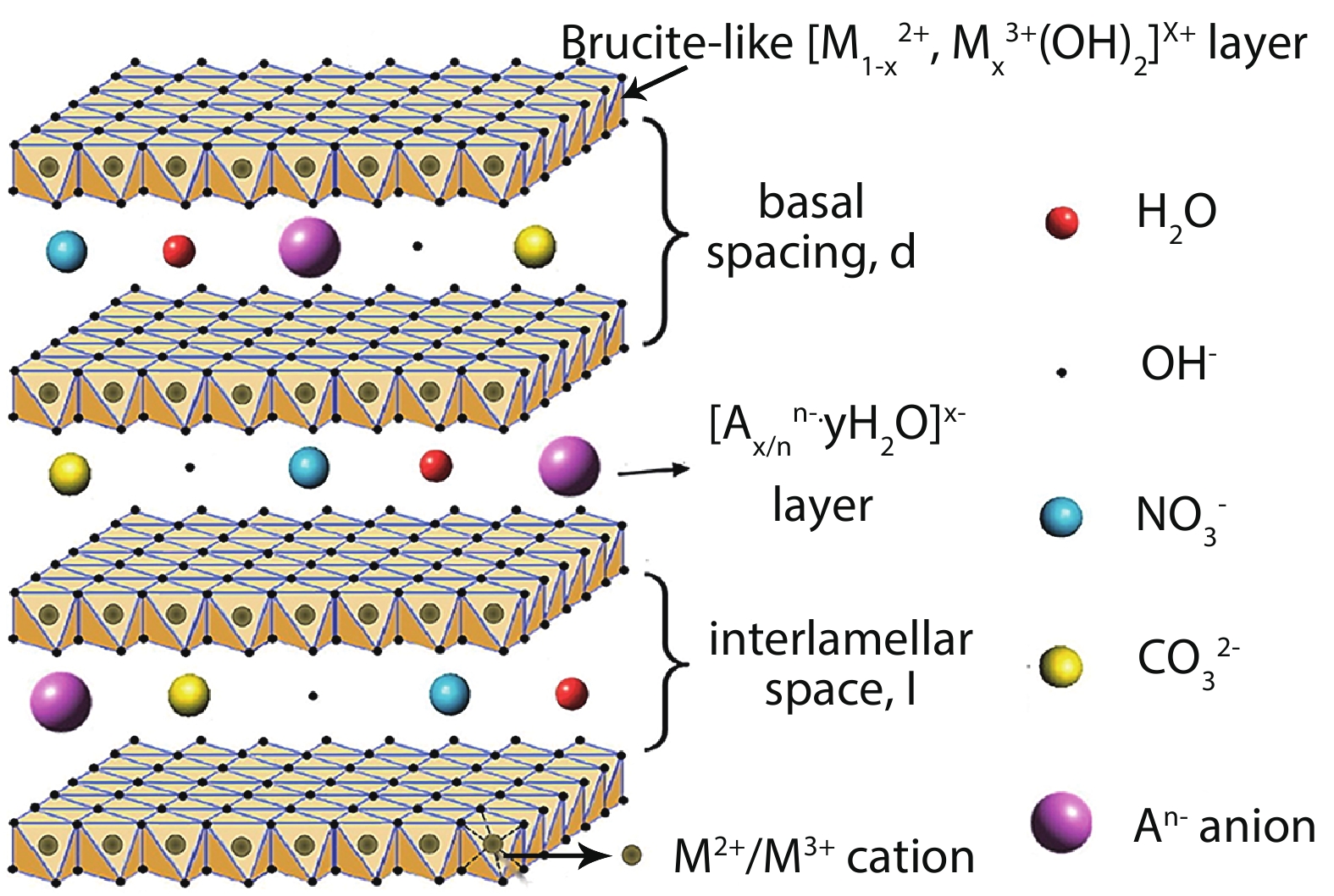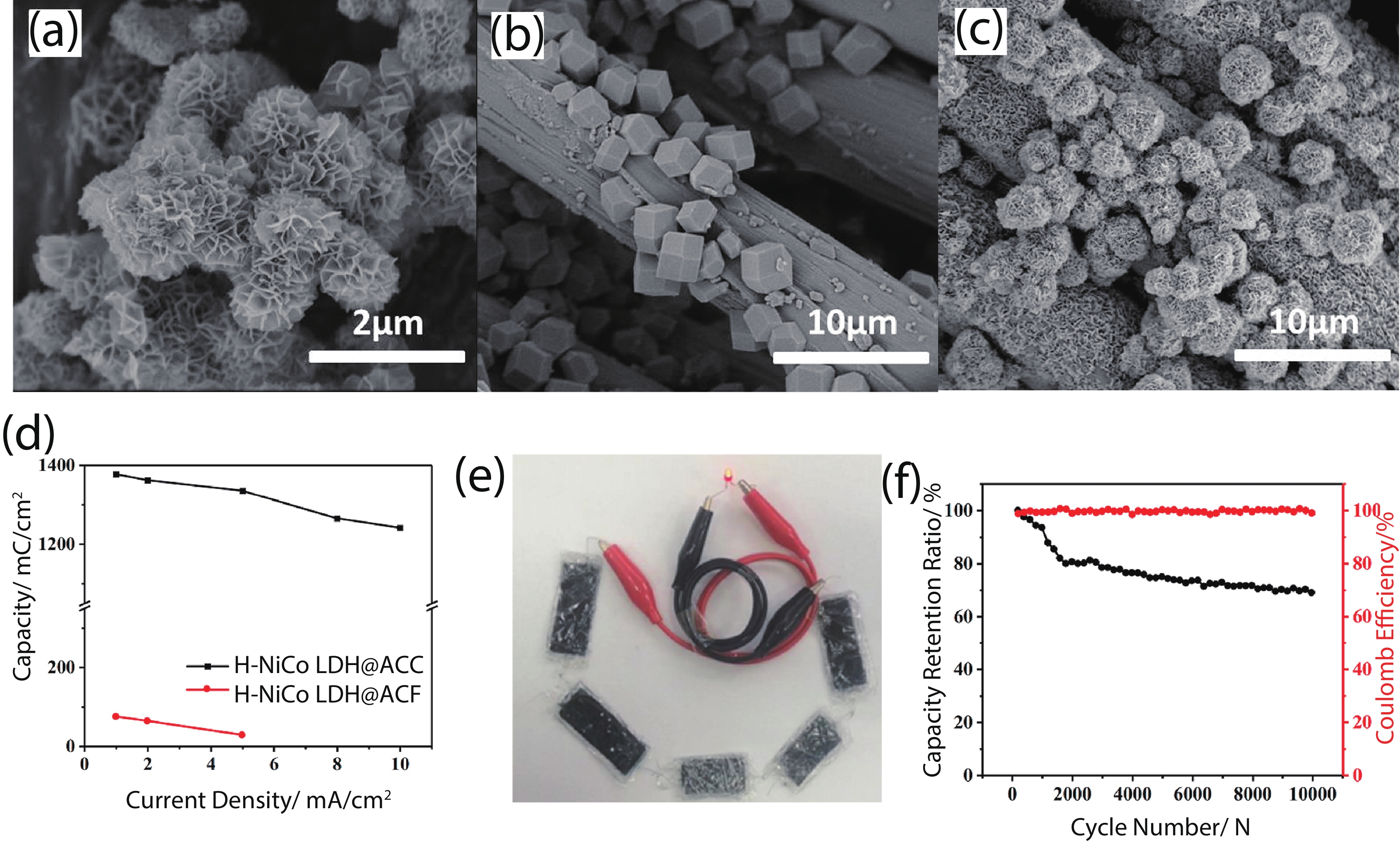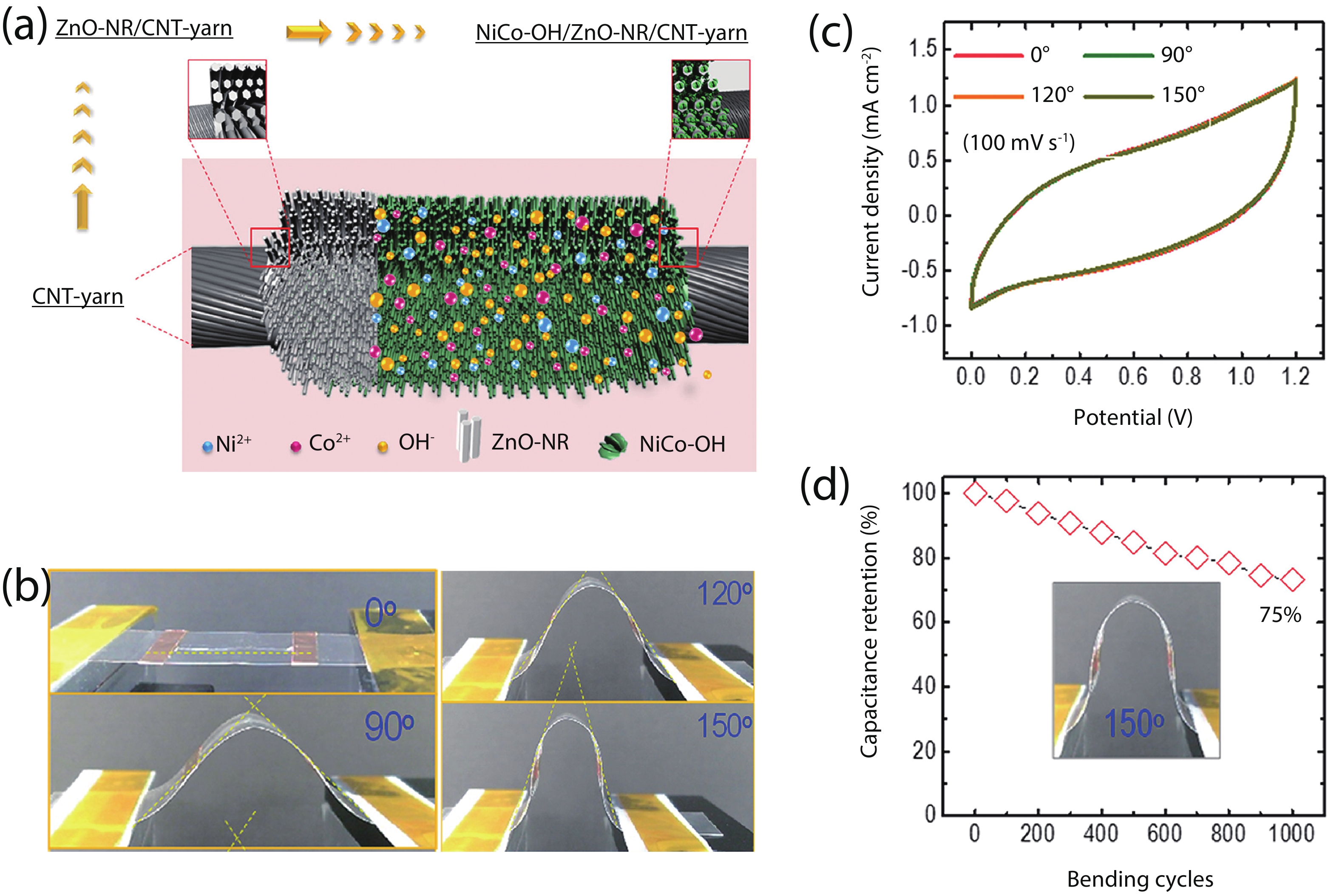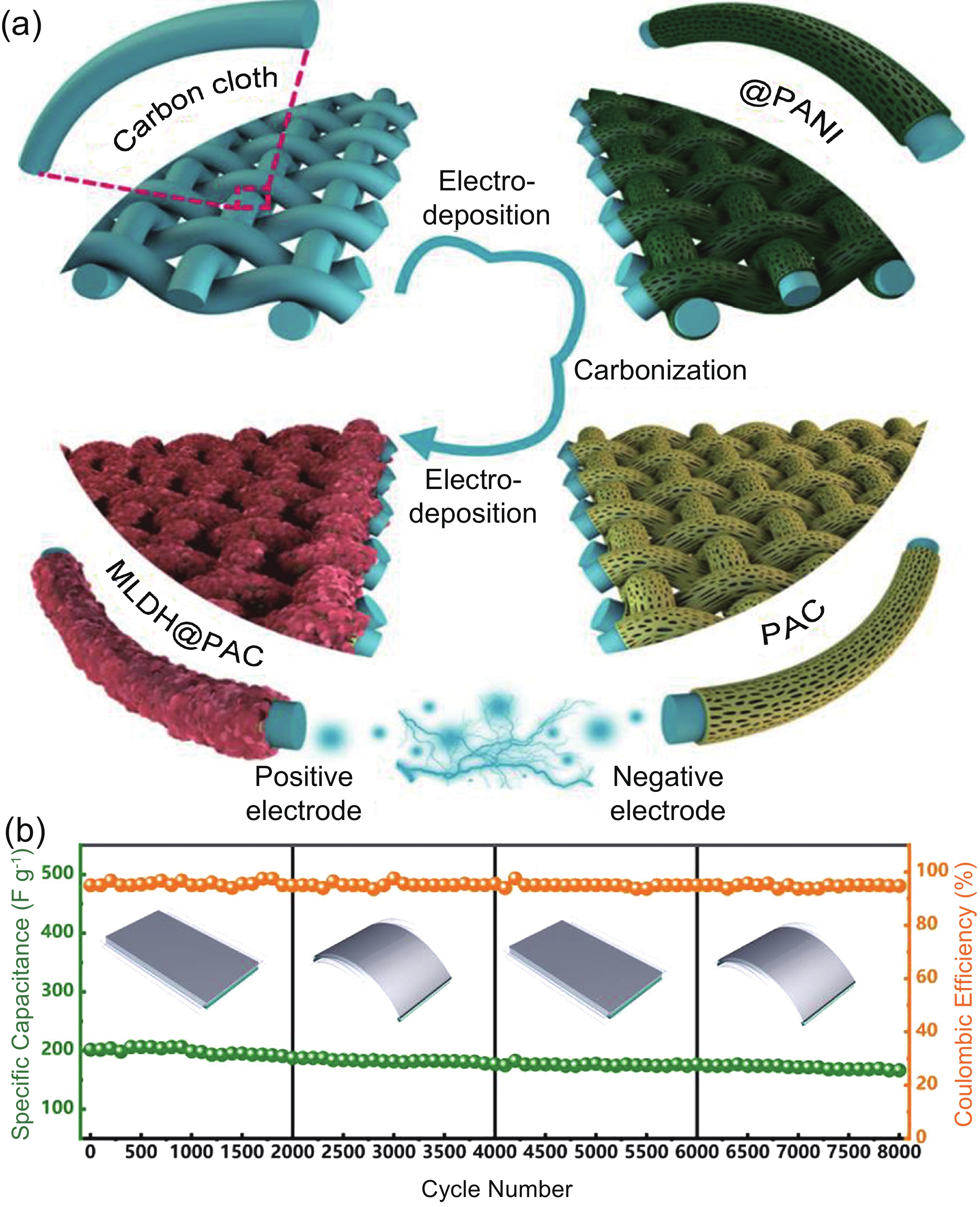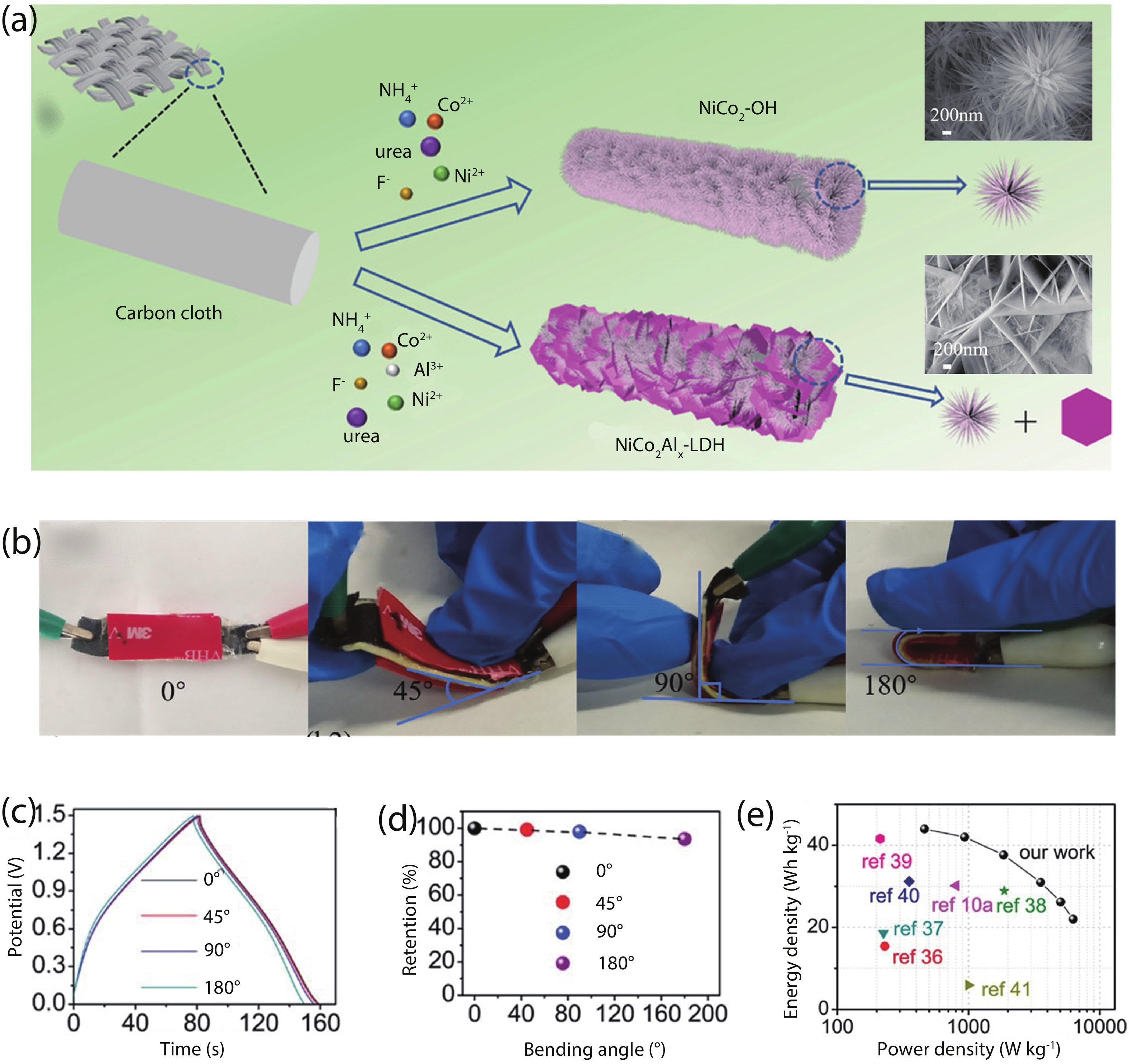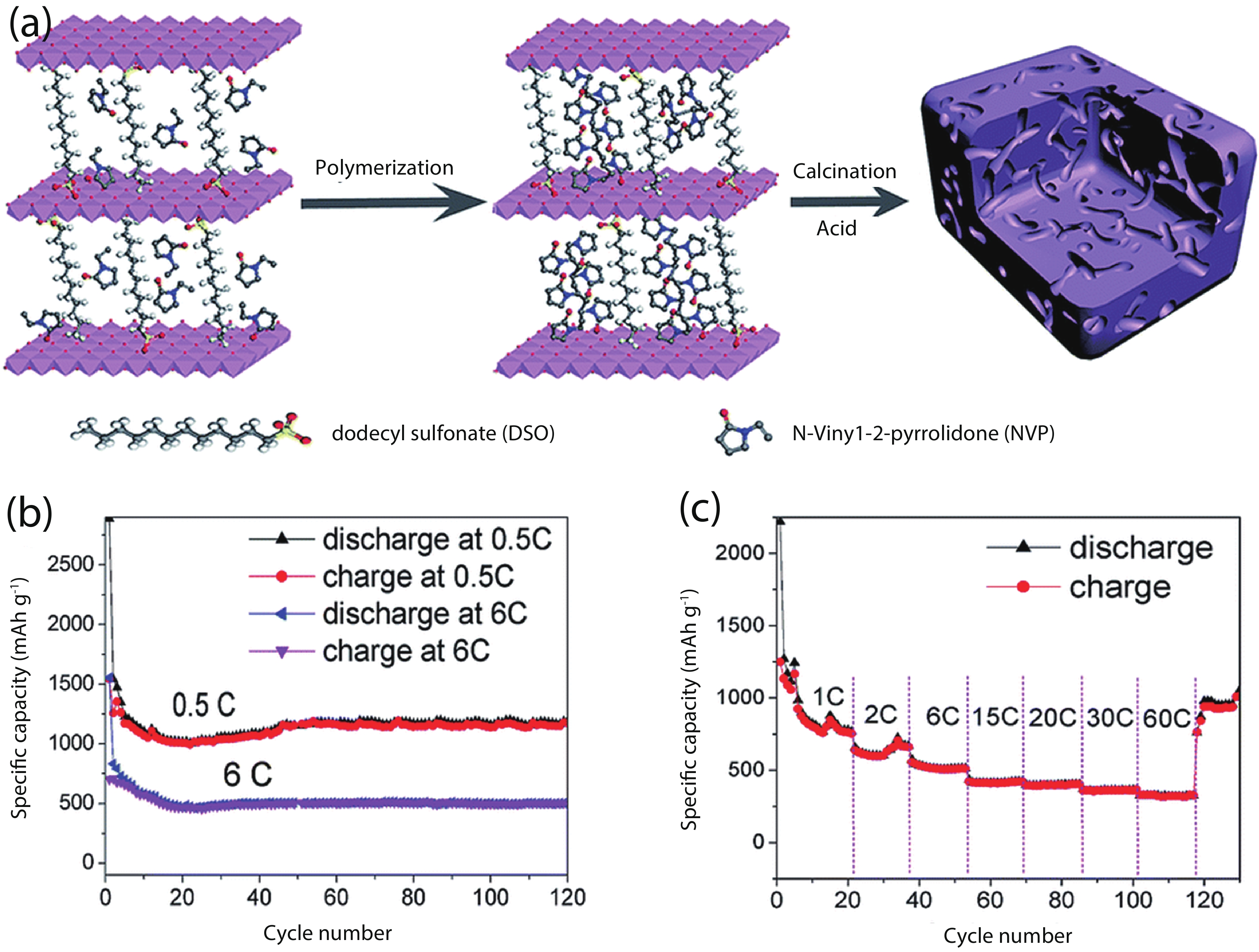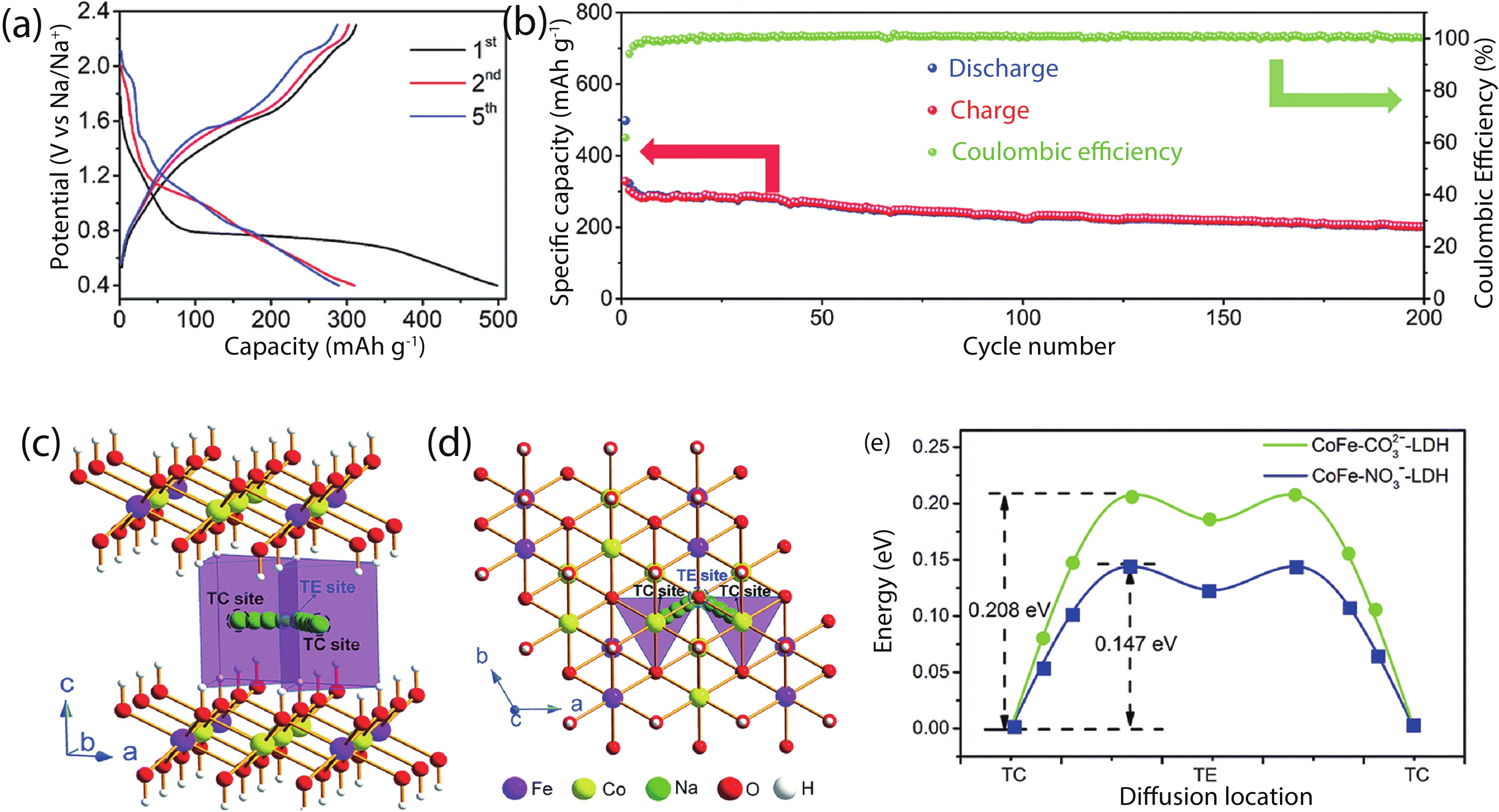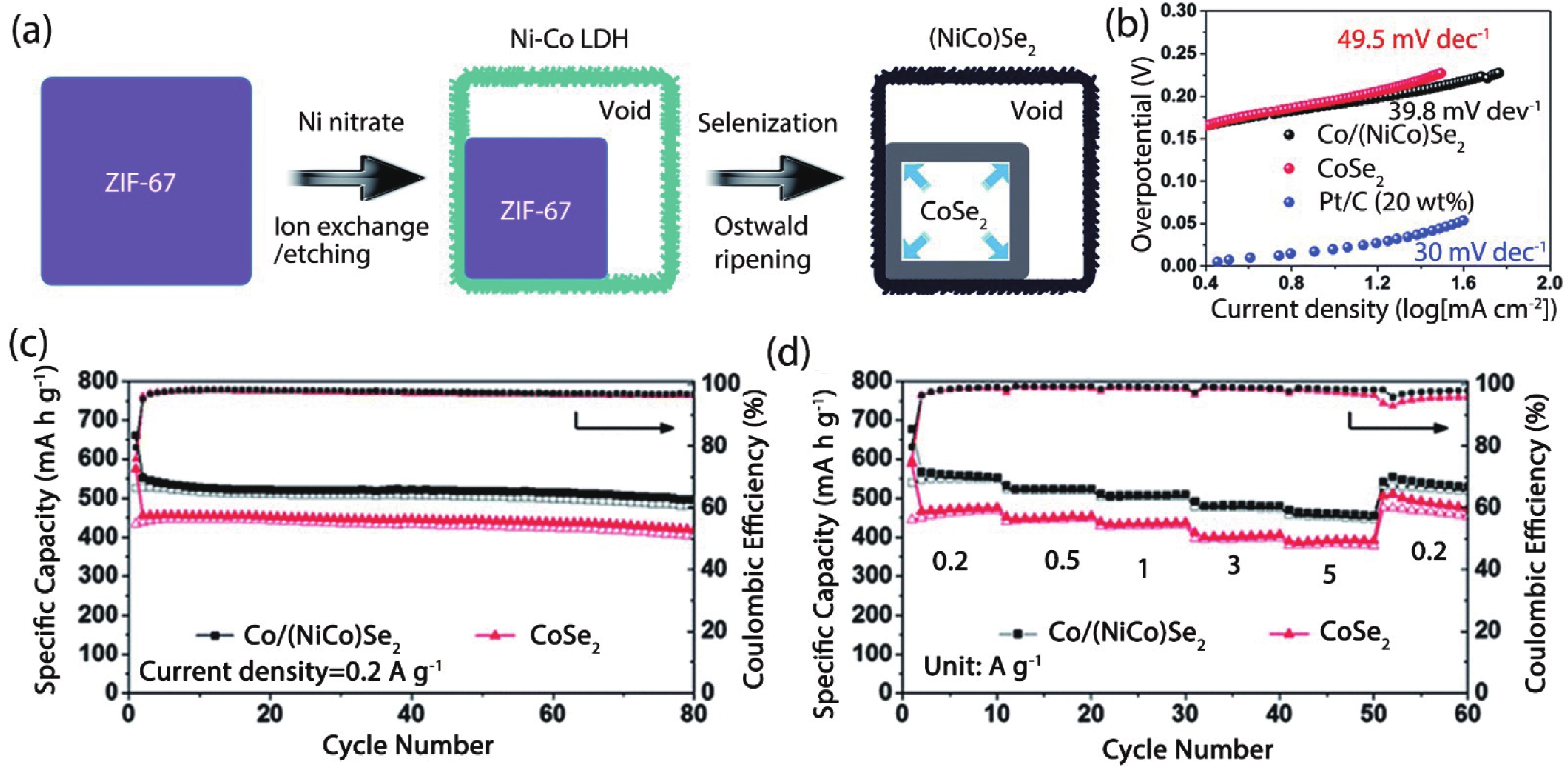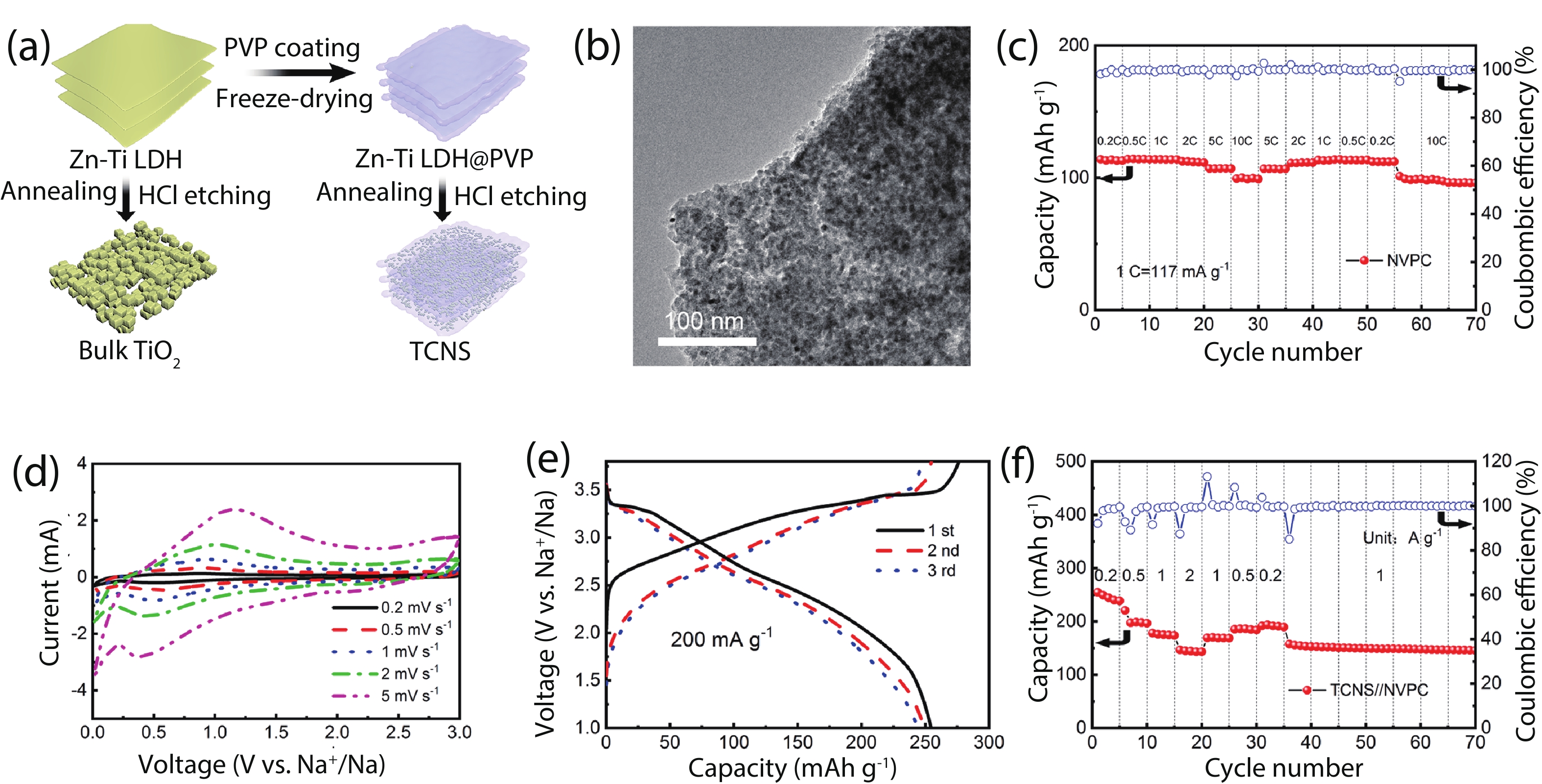| Citation: |
Qifeng Lin, Lili Wang. Layered double hydroxides as electrode materials for flexible energy storage devices[J]. Journal of Semiconductors, 2023, 44(4): 041601. doi: 10.1088/1674-4926/44/4/041601
Q F Lin, L L Wang. Layered double hydroxides as electrode materials for flexible energy storage devices[J]. J. Semicond, 2023, 44(4): 041601. doi: 10.1088/1674-4926/44/4/041601
Export: BibTex EndNote
|
Layered double hydroxides as electrode materials for flexible energy storage devices
doi: 10.1088/1674-4926/44/4/041601
More Information-
Abstract
To prevent and mitigate environmental degradation, high-performance and cost-effective electrochemical flexible energy storage systems need to be urgently developed. This demand has led to an increase in research on electrode materials for high-capacity flexible supercapacitors and secondary batteries, which have greatly aided the development of contemporary digital communications and electric vehicles. The use of layered double hydroxides (LDHs) as electrode materials has shown productive results over the last decade, owing to their easy production, versatile composition, low cost, and excellent physicochemical features. This review highlights the distinctive 2D sheet-like structures and electrochemical characteristics of LDH materials, as well as current developments in their fabrication strategies for expanding the application scope of LDHs as electrode materials for flexible supercapacitors and alkali metal (Li, Na, K) ion batteries. -
References
[1] Tang Y, Li X, Lv H, et al. Integration designs toward new-generation wearable energy supply-sensor systems for real-time health monitoring: A minireview. InfoMat, 2020, 2, 1109 doi: 10.1002/inf2.12102[2] Liu L, Zhao H, Lei Y. Advances on three-dimensional electrodes for micro-supercapacitors: A mini-review. InfoMat, 2019, 1, 71 doi: 10.1002/inf2.12007[3] Zhang Y, Cao J, Yuan Z, et al. TiVCTx MXene/chalcogenide heterostructure-based high-performance magnesium-ion battery as flexible integrated units. Small, 2022, 2202313 doi: 10.1002/smll.202202313[4] Wang H, Zhang N, Li S M, et al. Metal-organic framework composites for energy conversion and storage. J Semicond, 2020, 41, 091707 doi: 10.1088/1674-4926/41/9/091707[5] Baig N, Sajid M. Applications of layered double hydroxides based electrochemical sensors for determination of environmental pollutants: A review. Trends Environ Anal Chem, 2017, 16, 1 doi: 10.1016/j.teac.2017.10.003[6] Dong K, Wang Z L. Self-charging power textiles integrating energy harvesting triboelectric nanogenerators with energy storage batteries/supercapacitors. J Semicond, 2021, 42, 101601 doi: 10.1088/1674-4926/42/10/101601[7] Dong K, Hu Y, Yang J, et al. Smart textile triboelectric nanogenerators: Current status and perspectives. MRS Bulletin, 2021, 46, 512 doi: 10.1557/s43577-021-00123-2[8] Li M, Lu J, Chen Z, et al. 30 years of lithium-ion batteries. Adv Mater, 2018, 30, 1800561 doi: 10.1002/adma.201800561[9] Li X, Du D, Zhang Y, et al. Layered double hydroxides toward high-performance supercapacitors. J Mater Chem A, 2017, 5, 15460 doi: 10.1039/C7TA04001F[10] Zhang Y, Cao J, Li J, et al. Self-assembled Cobalt-doped NiMn-layered double hydroxide (LDH)/V2CTx MXene hybrids for advanced aqueous electrochemical energy storage properties. Chem Eng J, 2022, 430, 132992 doi: 10.1016/j.cej.2021.132992[11] Yan A L, Wang X C, Cheng J P. Research progress of NiMn layered double hydroxides for supercapacitors: A review. Nanomaterials, 2018, 8, 747 doi: 10.3390/nano8100747[12] Shou Q, Cheng J, Zhang L, et al. Synthesis and characterization of a nanocomposite of goethite nanorods and reduced graphene oxide for electrochemical capacitors. J Solid State Chem, 2012, 185, 191 doi: 10.1016/j.jssc.2011.11.020[13] Meng H, Xi W, Ren Z, et al. Solar-boosted electrocatalytic oxygen evolution via catalytic site remodelling of CoCr layered double hydroxide. Appl Catal B, 2021, 284, 119707 doi: 10.1016/j.apcatb.2020.119707[14] Fan G, Li F, Evans D G, et al. Catalytic applications of layered double hydroxides: recent advances and perspectives. Chem Soc Rev, 2014, 43, 7040 doi: 10.1039/C4CS00160E[15] Ma J, Chen Y, He G, et al. A robust H-transfer redox mechanism determines the high-efficiency catalytic performance of layered double hydroxides. Appl Catal B, 2021, 285, 119806 doi: 10.1016/j.apcatb.2020.119806[16] Zhao S, Ran W, Lou Z, et al. Neuromorphic-computing-based adaptive learning using ion dynamics in flexible energy storage devices. Natl Sci Rev, 2022, 9, nwac158 doi: 10.1093/nsr/nwac158[17] Li L, Zhao S, Ran W, et al. Dual sensing signal decoupling based on tellurium anisotropy for VR Interaction and neuro-reflex system application. Nat Commun, 2022, 13, 5975 doi: 10.1038/s41467-022-33716-9[18] Jiang S D, Bai Z M, Tang G, et al. Synthesis of mesoporous silica@Co-Al layered double hydroxide spheres: layer-by-layer method and their effects on the flame retardancy of epoxy resins. ACS Appl Mater Interfaces, 2014, 6, 14076 doi: 10.1021/am503412y[19] Xu S, Li S Y, Zhang M, et al. Fabrication of green alginate-based and layered double hydroxides flame retardant for enhancing the fire retardancy properties of polypropylene. Carbohydr Polym, 2020, 234, 115891 doi: 10.1016/j.carbpol.2020.115891[20] Ameena Shirin V K, Sankar R, Johnson A P, et al. Advanced drug delivery applications of layered double hydroxide. J Control Release, 2021, 330, 398 doi: 10.1016/j.jconrel.2020.12.041[21] Xu T, Zhang J, Chi H, et al. Multifunctional properties of organic-inorganic hybrid nanocomposites based on chitosan derivatives and layered double hydroxides for ocular drug delivery. Acta Biomater, 2016, 36, 152 doi: 10.1016/j.actbio.2016.02.041[22] Cao J, Wang L, Li D, et al. Ti3C2Tx MXene conductive layer supported bio-derived Fe x-1Se x/MXene/carbonaceous nanoribbons for high-performance half/full sodium-ion and potassium-ion batteries. Adv Mater, 2021, 33, 2101535 doi: 10.1002/adma.202101535[23] Zhang Y, Wang L, Zhao L, et al. Flexible self-powered intergrated sensing system with 3D periodic ordered black phosphorus@MXene thin-film. Adv Mater, 2021, 33, 2007890 doi: 10.1002/adma.202007890[24] Laipan M, Yu J, Zhu R, et al. Functionalized layered double hydroxides for innovative applications. Mater Horiz, 2020, 7, 715 doi: 10.1039/C9MH01494B[25] Mittal J. Recent progress in the synthesis of layered double hydroxides and their application for the adsorptive removal of dyes: A review. J Environ Manage, 2021, 295, 113017 doi: 10.1016/j.jenvman.2021.113017[26] Sarfraz M, Shakir I. Recent advances in layered double hydroxides as electrode materials for high-performance electrochemical energy storage devices. J Energy Storage, 2017, 13, 103 doi: 10.1016/j.est.2017.06.011[27] Yu J, Wang Q, O'Hare D, et al. Preparation of two dimensional layered double hydroxide nanosheets and their applications. Chem Soc Rev, 2017, 46, 5950 doi: 10.1039/C7CS00318H[28] Tao H, Fan Q, Ma T, et al. Two-dimensional materials for energy conversion and storage. Prog Mater Sci, 2020, 111, 100637 doi: 10.1016/j.pmatsci.2020.100637[29] Baker C O, Huang X, Nelson W, et al. Polyaniline nanofibers: broadening applications for conducting polymers. Chem Soc Rev, 2017, 46, 1510 doi: 10.1039/C6CS00555A[30] Liu L, Niu Z, Chen J. Unconventional supercapacitors from nanocarbon-based electrode materials to device configurations. Chem Soc Rev, 2016, 45, 4340 doi: 10.1039/C6CS00041J[31] Chen C, Zhang Y, Li Y, et al. Wood low tortuosity, aqueous, biodegradable supercapacitors with ultra-high capacitance. Energy Environl Sci, 2017, 10, 538 doi: 10.1039/C6EE03716J[32] Gao X, Wang P, Pan Z, et al. Recent progress in two-dimensional layered double hydroxides and their derivatives for supercapacitors. ChemSusChem, 2020, 13, 1226 doi: 10.1002/cssc.201902753[33] Ma L, Liu R, Niu H, et al. Flexible and freestanding supercapacitor electrodes based on nitrogen-doped carbon networks/graphene/bacterial cellulose with ultrahigh areal capacitance. ACS Appl Mater Interfaces, 2016, 8, 33608 doi: 10.1021/acsami.6b11034[34] Liang J, Feng Y, Liu L, et al. All-printed solid-state supercapacitors with versatile shapes and superior flexibility for wearable energy storage. J Mater Chem A, 2019, 7, 15960 doi: 10.1039/C9TA03513C[35] Dong K, Peng X, Cheng R, et al. Advances in high-performance autonomous energy and self-powered sensing textiles with novel 3D fabric structures. Adv Mater, 2022, 34, 2109355 doi: 10.1002/adma.202109355[36] Dong K, Peng X, Cheng R, et al. Smart textile triboelectric nanogenerators: Prospective strategies for improving electricity output performance. Nanoenergy Adv, 2022, 2, 133 doi: 10.3390/nanoenergyadv2010006[37] Jin S, Allam O, Jang S, et al. Covalent organic frameworks: Design and applications in electrochemical energy storage devices. InfoMat, 2022, 4, e12277 doi: 10.1002/inf2.12277[38] Zhao M, Zhao Q, Li B, et al. Recent progress in layered double hydroxide based materials for electrochemical capacitors: design, synthesis and performance. Nanoscale, 2017, 9, 15206 doi: 10.1039/C7NR04752E[39] Lu Z, Qian L, Tian Y, et al. Ternary NiFeMn layered double hydroxides as highly-efficient oxygen evolution catalysts. Chem Commun, 2016, 52, 908 doi: 10.1039/C5CC08845C[40] Wang R, Yao M, Niu Z. Smart supercapacitors from materials to devices. InfoMat, 2020, 2, 2148 doi: 10.1002/inf2.12037[41] Lan Y, Zhao H, Zong Y, et al. Phosphorization boosts the capacitance of mixed metal nanosheet arrays for high performance supercapacitor electrodes. Nanoscale, 2018, 10, 11775 doi: 10.1039/C8NR01229F[42] Yuan Z, Cao J, Valerii S, et al. MXene-bonded hollow MoS2/carbon sphere strategy for high-performance flexible sodium ion storage. Chem Eng J, 2022, 430, 132755 doi: 10.1016/j.cej.2021.132755[43] Li X, Shen J, Sun W, et al. A super-high energy density asymmetric supercapacitor based on 3D core–shell structured NiCo-layered double hydroxide@carbon nanotube and activated polyaniline-derived carbon electrodes with commercial level mass loading. J Mater Chem A, 2015, 3, 13244 doi: 10.1039/C5TA01292A[44] Xuan X, Qian M, Han L, et al. In-situ growth of hollow NiCo layered double hydroxide on carbon substrate for flexible supercapacitor. Electrochimica Acta, 2019, 321, 134710 doi: 10.1016/j.electacta.2019.134710[45] Lau C N, Bao W, Velasco J. Properties of suspended graphene membranes. Mater Today, 2012, 15, 238 doi: 10.1016/S1369-7021(12)70114-1[46] Castro Neto A H, Guinea F, Peres N M R, et al. The electronic properties of graphene. Rev Mod Phys, 2009, 81, 109 doi: 10.1103/RevModPhys.81.109[47] Kiran S K, Shukla S, Struck A, et al. Surface enhanced 3D rGO hybrids and porous rGO nano-networks as high performance supercapacitor electrodes for integrated energy storage devices. Carbon, 2020, 158, 527 doi: 10.1016/j.carbon.2019.11.021[48] Chen T, Dai L. Flexible supercapacitors based on carbon nanomaterials. J Mater Chem A, 2014, 2, 10756 doi: 10.1039/c4ta00567h[49] Senthilkumar S T, Wang Y, Huang H. Advances and prospects of fiber supercapacitors. J Mater Chem A, 2015, 3, 20863 doi: 10.1039/C5TA04731E[50] Xu P, Gu T, Cao Z, et al. Carbon nanotube fiber based stretchable wire-shaped supercapacitors. Adv Energy Mater, 2014, 4, 1300759 doi: 10.1002/aenm.201300759[51] Le T S, Truong T K, Huynh V N, et al. Synergetic design of enlarged surface area and pseudo-capacitance for fiber-shaped supercapacitor yarn. Nano Energy, 2020, 67, 104198 doi: 10.1016/j.nanoen.2019.104198[52] Li L, Zhou Y, Zhou H, et al. N/P codoped porous carbon/one-dimensional hollow tubular carbon heterojunction from biomass inherent structure for supercapacitors. ACS Sustain Chem Eng, 2018, 7, 1337 doi: 10.1021/acssuschemeng.8b05022[53] Qin F, Tian X, Guo Z, et al. Asphaltene-based porous carbon nanosheet as electrode for supercapacitor. ACS Sustain Chem Eng, 2018, 6, 15708 doi: 10.1021/acssuschemeng.8b04227[54] Tabassum H, Zou R, Mahmood A, et al. A universal strategy for hollow metal oxide nanoparticles encapsulated into B/N Co-doped graphitic nanotubes as high-performance lithium-ion battery anodes. Adv Mater, 2018, 30, 1705441 doi: 10.1002/adma.201705441[55] Lee J, Kitchaev D A, Kwon D H, et al. Reversible Mn(2+)/Mn(4+) double redox in lithium-excess cathode materials. Nature, 2018, 556, 185 doi: 10.1038/s41586-018-0015-4[56] Chen H C, Qin Y, Cao H, et al. Synthesis of amorphous nickel–cobalt–manganese hydroxides for supercapacitor-battery hybrid energy storage system. Energy Storage Mater, 2019, 17, 194 doi: 10.1016/j.ensm.2018.07.018[57] Chen J, Wang X, Wang J, et al. Sulfidation of NiMn-layered double hydroxides/graphene oxide composites toward supercapacitor electrodes with enhanced performance. Adv Energy Mater, 2016, 6, 1501745 doi: 10.1002/aenm.201501745[58] Cao J, Li J, Li L, et al. Mn-doped Ni/Co LDH nanosheets grown on the natural N-dispersed PANI-derived porous carbon template for a flexible asymmetric supercapacitor. ACS Sustain Chem Eng, 2019, 7, 10699 doi: 10.1021/acssuschemeng.9b01343[59] Li M, Jijie R, Barras A, et al. NiFe layered double hydroxide electrodeposited on Ni foam coated with reduced graphene oxide for high-performance supercapacitors. Electrochimica Acta, 2001, 302, 1 doi: 10.1016/j.electacta.2019.01.187[60] Yang S, Liu Y, Hao Y, et al. Oxygen-vacancy abundant ultrafine Co3O4/graphene composites for high-rate supercapacitor electrodes. Adv Sci, 2018, 5, 1700659 doi: 10.1002/advs.201700659[61] Yin B, Zhang S, Jiao Y, et al. Facile synthesis of ultralong MnO2 nanowires as high performance supercapacitor electrodes and photocatalysts with enhanced photocatalytic activities. CrystEngComm, 2014, 16, 9999 doi: 10.1039/C4CE01302F[62] Yin B, Zhang S, Jiang H, et al. Phase-controlled synthesis of polymorphic MnO2 structures for electrochemical energy storage. J Mater Chem A, 2015, 3, 5722 doi: 10.1039/C4TA06943A[63] Zhao Y, He J, Dai M, et al. Emerging CoMn-LDH@MnO2 electrode materials assembled using nanosheets for flexible and foldable energy storage devices. J Energy Chem, 2020, 45, 67 doi: 10.1016/j.jechem.2019.09.027[64] Wang Y, Yang H, Lv H, et al. High performance flexible asymmetric supercapacitor constructed by cobalt aluminum layered double hydroxide@nickel cobalt layered double hydroxide heterostructure grown in-situ on carbon cloth. J Colloid Interface Sci, 2022, 610, 35 doi: 10.1016/j.jcis.2021.12.019[65] Li Y, Yan X, Zhang W, et al. Hierarchical micro-nano structure based NiCoAl-LDH nanosheets reinforced by NiCo2S4 on carbon cloth for asymmetric supercapacitor. J Electroanal Chem, 2022, 905, 115982 doi: 10.1016/j.jelechem.2021.115982[66] Ni C S, Liu S F, Lee J F, et al. Binder-free NiCoFe layered double hydroxide nanosheets for flexible energy storage devices with high-rate-retention characteristics. Electrochimica Acta, 2021, 384, 138415 doi: 10.1016/j.electacta.2021.138415[67] He F, Hu Z, Liu K, et al. Facile fabrication of GNS/NiCoAl-LDH composite as an advanced electrode material for high-performance supercapacitors. J Solid State Electr, 2014, 19, 607 doi: 10.1007/s10008-014-2644-3[68] Bai X, Liu Q, Liu J, et al. All-solid state asymmetric supercapacitor based on NiCoAl layered double hydroxide nanopetals on robust 3D graphene and modified mesoporous carbon. Chem Eng J, 2017, 328, 873 doi: 10.1016/j.cej.2017.07.118[69] Xu J, Gai S, He F, et al. Reduced graphene oxide/Ni1– xCo xAl-layered double hydroxide composites: preparation and high supercapacitor performance. Dalton Trans, 2014, 43, 11667 doi: 10.1039/C4DT00686K[70] He X, Liu Q, Liu J, et al. Hierarchical NiCo2O4@NiCoAl-layered double hydroxide core/shell nanoforest arrays as advanced electrodes for high-performance asymmetric supercapacitors. J Alloys Compd, 2017, 724, 130 doi: 10.1016/j.jallcom.2017.06.256[71] Wang X, Li H, Li H, et al. Heterostructures of Ni–Co–Al layered double hydroxide assembled on V4C3MXene for high-energy hybrid supercapacitors. J Mater Chem A, 2019, 7, 2291 doi: 10.1039/C8TA11249E[72] Gao X, Liu X, Wu D, et al. Significant role of Al in ternary layered double hydroxides for enhancing electrochemical performance of flexible asymmetric supercapacitor. Adv Funct Mater, 2019, 29, 1903879 doi: 10.1002/adfm.201903879[73] Poudel M B, Kim H J. Confinement of Zn-Mg-Al-layered double hydroxide and α-Fe2O3 nanorods on hollow porous carbon nanofibers: A free-standing electrode for solid-state symmetric supercapacitors. Chem Eng J, 2022, 429, 132345 doi: 10.1016/j.cej.2021.132345[74] Xu S F, Sun M X, Wang Q, et al. Recent progress in organic electrodes for zinc-ion batteries. J Semicond, 2020, 41, 091704 doi: 10.1088/1674-4926/41/9/091704[75] Chen J, Li S, Qian K, et al. NiMn layered double hydroxides derived multiphase Mn-doped Ni sulfides with reduced graphene oxide composites as anode materials with superior cycling stability for sodium ion batteries. Mater Today Energy, 2018, 9, 74 doi: 10.1016/j.mtener.2018.02.008[76] Zhao X, Xu H, Hui Z. Electrostatically assembling 2D nanosheets of MXene and MOF-derivatives into 3D hollow frameworks for enhanced lithium storage. Small, 2019, 15, e1904255 doi: 10.1002/smll.201904255[77] Park S K, Kim J K, Kang Y. Metal –organic framework-derived CoSe2/(NiCo)Se2 box-in-box hollow nanocubes with enhanced electrochemical properties for sodium-ion storage and hydrogen evolution. J Mater Chem A, 2017, 5, 18823 doi: 10.1039/C7TA05571D[78] Zhu H, Sha M, Zhao H, et al. Highly-rough surface carbon nanofibers film as an effective interlayer for lithium–sulfur batteries. J Semicond, 2020, 41, 092701 doi: 10.1088/1674-4926/41/9/092701[79] Wang J, Wang L, Chen X, et al. Chemical power source based on layered double hydroxides. J Solid State Electr, 2015, 19, 1933 doi: 10.1007/s10008-014-2723-5[80] Liu J, Li Y, Huang X, et al. Layered double hydroxide nano- and microstructures grown directly on metal substrates and their calcined products for application as Li-ion battery electrodes. Adv Funct Mater, 2008, 18, 1448 doi: 10.1002/adfm.200701383[81] Zhang J, Yang Z, Qiu J, et al. Design and synthesis of nitrogen and sulfur co-doped porous carbon via two-dimensional interlayer confinement for a high-performance anode material for lithium-ion batteries. J Mater Chem A, 2016, 4, 5802 doi: 10.1039/C6TA00025H[82] Lu Y, Du Y, Li H. Template-sacrificing synthesis of Ni-Co layered double hydroxides polyhedron as advanced anode for lithium ions battery. Front Chem, 2020, 8, 581653 doi: 10.3389/fchem.2020.581653[83] Hantanasirisakul K, Gogotsi Y. Electronic and optical properties of 2D transition metal carbides and nitrides (MXenes). Adv Mater, 2018, 30, e1804779 doi: 10.1002/adma.201804779[84] Delmas C. Sodium and sodium-ion batteries: 50 years of research. Adv Energy Mater, 2018, 8, 1703137 doi: 10.1002/aenm.201703137[85] Okamoto K, Iyi N, Sasaki T. Factors affecting the crystal size of the MgAl-LDH (layered double hydroxide) prepared by using ammonia-releasing reagents. Appl Clay Sci, 2007, 37, 23 doi: 10.1016/j.clay.2006.10.008[86] Inayat A, Klumpp M, Schwieger W, et al. The urea method for the direct synthesis of ZnAl layered double hydroxides with nitrate as the interlayer anion. Appl Clay Sci, 2011, 51, 452 doi: 10.1016/j.clay.2011.01.008[87] Zhao Y, Sun T, Yin Q, et al. Discovery of a new intercalation-type anode for high-performance sodium ion batteries. J Mater Chem A, 2019, 7, 15371 doi: 10.1039/C9TA03753E[88] Diao Z, Wang Y, Zhao D, et al. Ultra-small TiO2 nanoparticles embedded in carbon nanosheets for high-performance sodium storage. Chem Eng J, 2021, 417, 127928 doi: 10.1016/j.cej.2020.127928[89] Zhang W, Yin J, Wang W, et al. Status of rechargeable potassium batteries. Nano Energy, 2021, 83, 105792 doi: 10.1016/j.nanoen.2021.105792[90] Eftekhari A, Jian Z, Ji X. Potassium secondary batteries. ACS Appl Mater Interfaces, 2017, 9, 4404 doi: 10.1021/acsami.6b07989[91] Zhou J, Liu Y, Zhang S, et al. Metal chalcogenides for potassium storage. InfoMat, 2020, 2, 437 doi: 10.1002/inf2.12101[92] Li C, Li P, Yang S, Zhi C Y. Recently advances in flexible zinc ion batteries. J Semicond, 2021, 42, 101603 doi: 10.1088/1674-4926/42/10/101603[93] Deng S, Cheng S, Liu M, et al. Modulating magnetic properties by tailoring in-plane domain structures in hexagonal YMnO3 films. ACS Appl Mater Interfaces, 2016, 8, 25379 doi: 10.1021/acsami.6b08024[94] Yang Q, Lv K, Liang L, et al. Layered double hydroxides as high-performance anode material for potassium ion battery. J Alloys Compd, 2021, 882, 160711 doi: 10.1016/j.jallcom.2021.160711[95] Jiang Q, Wang L, Zhao W, et al. Carbon dots decorated on the ultrafine metal sulfide nanoparticles implanted hollow layered double hydroxides nanocages as new-type anodes for potassium-ion batteries. Chem Eng J, 2022, 433, 133539 doi: 10.1016/j.cej.2021.133539[96] Ma X H, Jiang Z F, Lin Y J. Flexible energy storage devices for wearable bioelectronics. J Semicond, 2021, 42, 101602 doi: 10.1088/1674-4926/42/10/101602[97] Zhao C, Wang Z J, Shu D J, et al. Preface to the special issue on challenges and possibilities of energy storage. J Semicond, 2020, 41, 090101 doi: 10.1088/1674-4926/41/9/090101 -
Proportional views





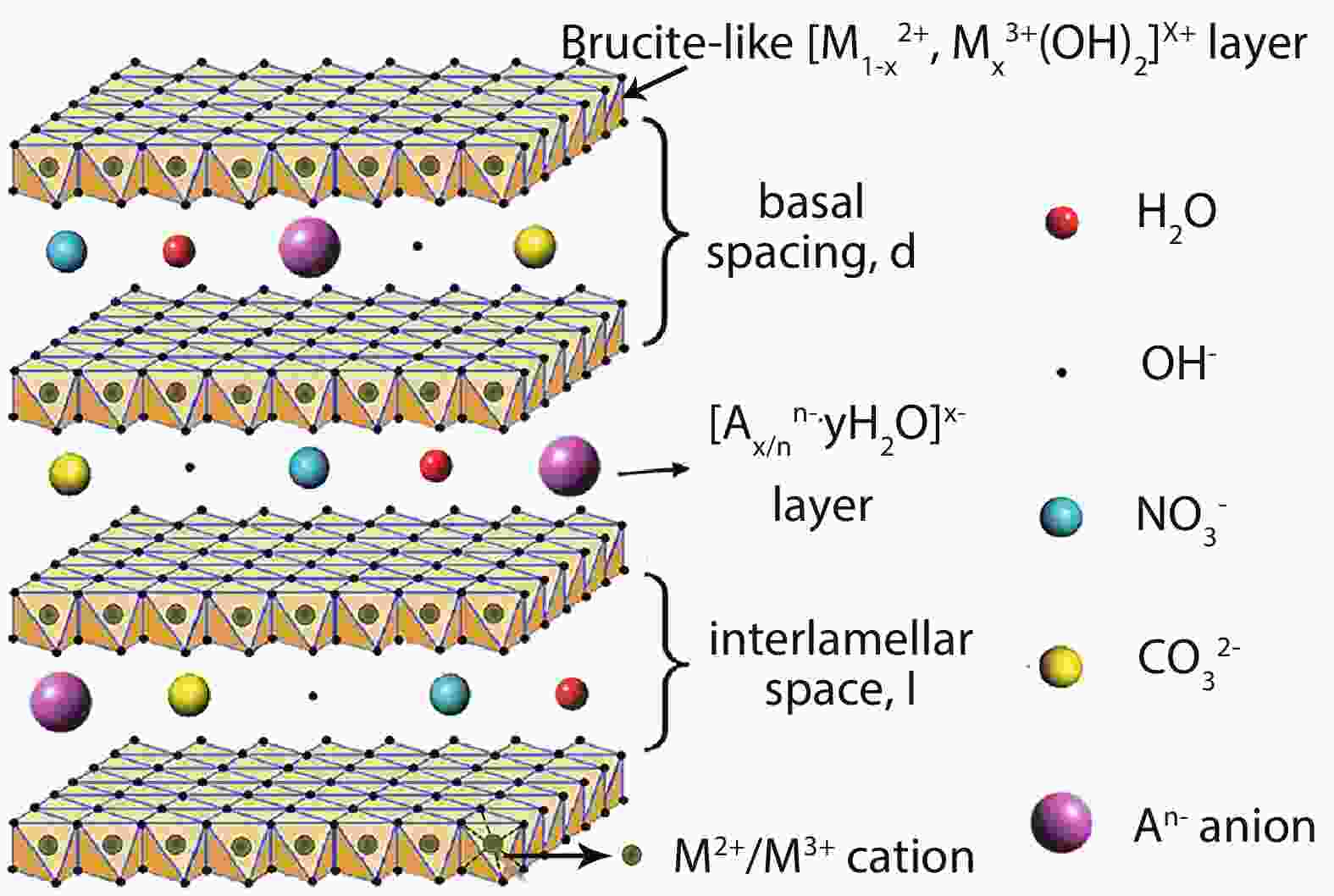
 DownLoad:
DownLoad:

